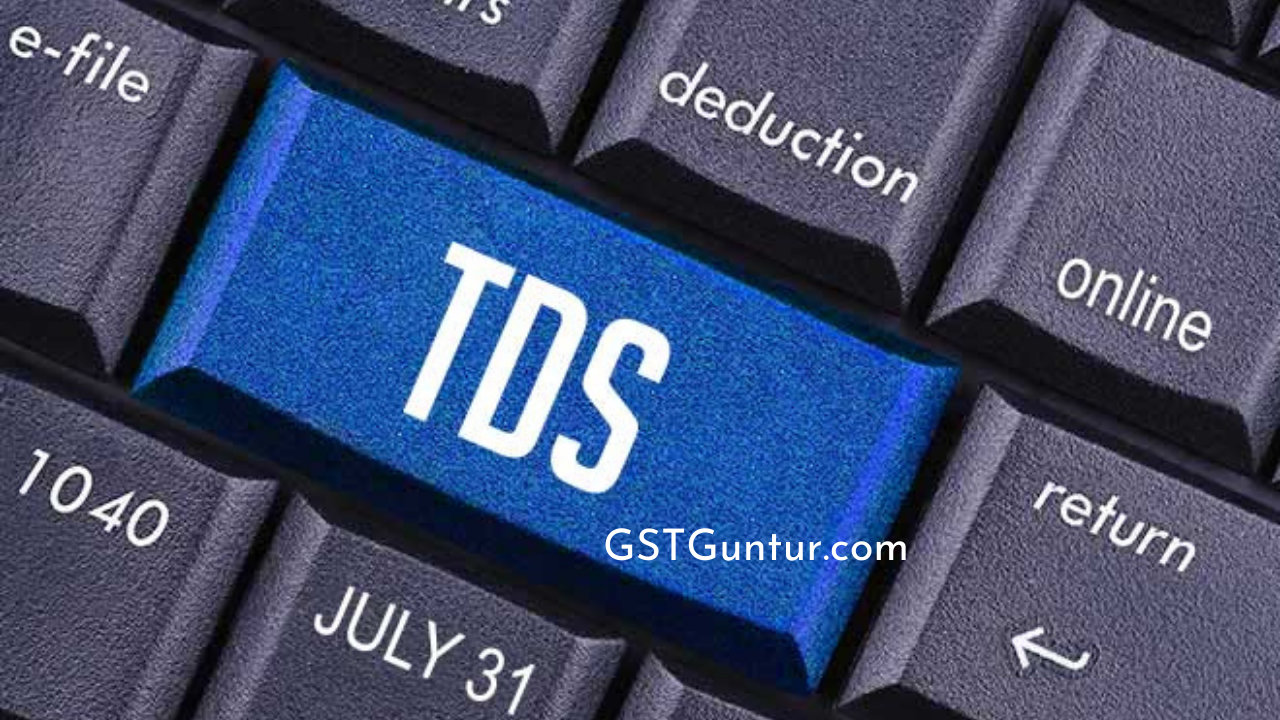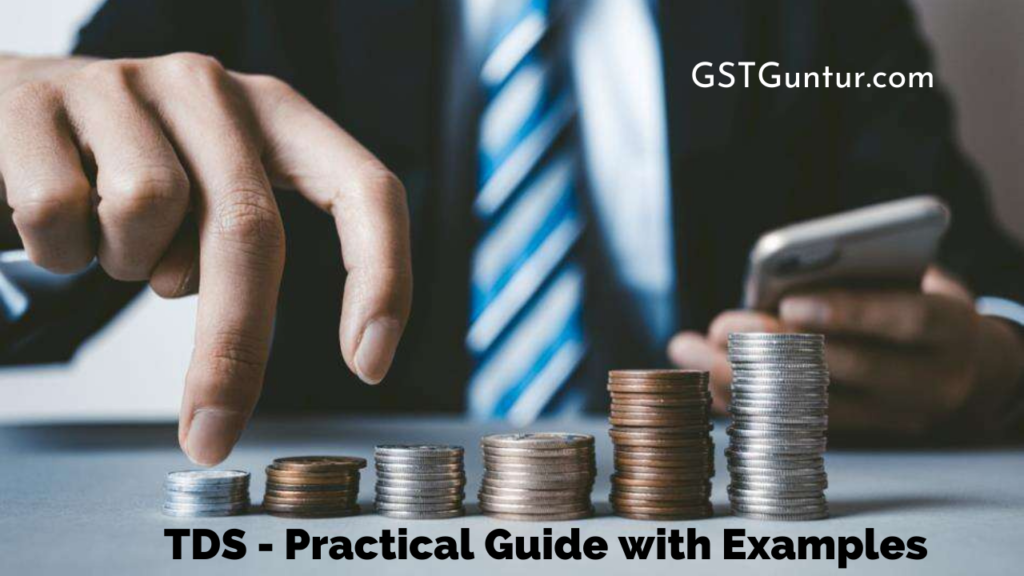TDS: TDS stands for Tax Deducted Source. In the TDS system, individuals responsible for making payment for specified services such as brokerage, professional consultancy, commission, etc., are required to subtract a fixed percentage from the amount.
- About TDS
- Persons Who Are Required to Deduct TDS
- What is TAN? Its Requirement and Exception
- When to deduct TDS?
- The Threshold Limits and Nature of Payments
- Payment And Return Filing
- TDS Certificate
- The Nature of Payment and Due Dates
- Provisions for Penalty
- Utility to Check the Amount Deducted and Credited to Deductee’s Account
- Request For Non-Deduction or Lower Deduction
- Applying For a Refund
About TDS
The like deducted amount (which is called TDS) have to be deposited to the government by the deductor (person who is deducting tax) on behalf of the deductee (person who is providing services), which deductee can claim as Income Tax Paid at the time of filing his Income Tax Return.
- For example, ABC Pvt Ltd has to pay Rs 1,00,000 to Mr XYZ for a professional fee. TDS rate specified on the professional cost is 10%. The TDS needed to be deducted 10% on Rs 1,00,000, which equals Rs 10,000, and the Net payment to Mr XYZ is TDS Deducted from the Gross Amount that equals Rs 1,00,000 – Rs 10,000 and gives Rs 90,000. So, the TDS to be deposited to the Government by ABC Pvt Ltd is Rs 10,000.
TDS can also be deducted from salary. The calculation of tax subtractable is different in the case of wages since TDS is not deductible as a fixed percentage but according to a specific method under section 192.
Persons Who Are Required to Deduct TDS
The government has notified the persons mentioned below, who are required to subtract TDS for the services specified:
- An Individual and HUF is needed to deduct TDS on the selected services if they are involved in:
- Any business having a turnover of Rs 1 crore or above during the last financial year.
- A professional with receipts of Rs 50 lakh or above during the previous financial year must get books of account audited under section 44AB.
Exception
- If a person is required to get his books of account audited due to reporting the net profit, which is lower than 8% of the business’s turnover (according to Section 44 AD). According to Section 44ADA, 50% of the gross receipt in professional services; is not required to subtract TDS.
- Other persons apart from Individual and HUF include Private Limited Company, Partnership Firm, Co-operative Society, LLP, etc.
Exception for Individual and HUF
The cases below are also required to deduct TDS:
- In the case of the Purchase of immovable property where the consideration paid for the property is more than Rs 50 Lakh (as per Section 194IA).
- The rent paid for building exceeding or land exceeds Rs 50,000 per month (according to Section 194IB). Only those Individuals or HUF are covered, which are not required to deduct TDS as per the point mentioned above (as per section 194IB). If an individual is covered as per point (a), they must deduct TDS under section 194I and not section 194IB.
- The only two cases in which a non-business is also required to deduct TDS are mentioned above.
What is TAN? Its Requirement and Exception
The Tax Deduction and Collection Account Number (TAN) is a unique ten-digit alphanumeric number allotted to the deductor or collector of TDS. It is furnished to identify every deductor.
Each individual who is required to deduct TDS should apply for TAN. TAN is needed to be quoted on all TDS payment challans, TDS certificates & TDS returns. You can use Form 49B in any NSDL office, or you can also apply online for TAN from the NSDL website.
Penalty – The penalty of Rs. 10,000 on failing to apply for TAN or quoting TAN in payment challans, TDS return and TDS certificates.
The Time Limit to get a TAN
No specified time limit is given for getting TAN. However, you should apply for TAN when you become liable to deduct the TDS of any person since TDS payment and return filing cannot be accomplished without TAN.
Notes
- A separate TAN is not required to obtain TCS.
- If you have made any payment above the threshold limit and TDS is required to be deducted, you must apply for the TAN. For example, if you certify as a Private Limited Company and do not make any payment on which TDS is required to be deducted, there is no need for a TAN.
Exception
TAN is not required if TDS is deducted for Purchase of Immovable property (Section 194IA) or rent paid (Section – 194IB). Deductor has to use their PAN for the TDS payment and for filing returns.

When to Deduct TDS?
The time of deducting TDS depends on the nature of the payment. TDS is required to be removed at the time of actual payment only, not on a due or accrual basis in the following cases:
- Salary
- The Payment of the assembled balance of the Employee’s Provident Fund.
- Victory from lottery or crosswords puzzle.
- Win from horse races.
- The Payment in respect of life insurance policy to the policyholder.
- The Payment for deposits under the National Saving Scheme.
- The Payment on account of repurchase of units by Mutual Funds or Unit Trusts of India.
- The Payment of compensation on compulsory acquisition of specified immovable property.
During the time of credit of such income to the payee’s account or at the time of actual payment, whichever is earlier in case of all other payments (such as commission, profession fee, consultancy etc.) except the payments mentioned in the above point.
Note: TDS must be deducted from the beginning if it is likely that the total amount will exceed the threshold limit during the financial year.
For example: if you have a professional service contract amounting to Rs 2,00,000 and the first payment is due in April, adding up to Rs 13,000. If so, TDS is required to be deducted at 10%, as it is likely that the total amount will exceed the threshold limit.
The Threshold Limits and Nature of Payments
The points below summarize the nature of the transaction where TDS is required to be subtracted if the amount exceeds the threshold limit, together with the applicable rates of TDS for payments commonly used.
TDS Amount Calculation
TDS needs to be subtracted from the total amount if such amount exceeds the threshold limit specified for that particular nature of transactions.
Few examples which will help in understanding the calculation of TDS
Example 1 – Service provided by an individual contractor ‘A’ to a partnership firm ‘B’. The contractor during the year is being paid as per the payment that follows.
Payment 1 is Rs 32,000
Payment 2 is Rs 24,000
Payment 3 is 60,000.
Solution:
When Payment 1 is Rs 32,000: the TDS is required to be deducted at 1% as the sum exceeds the threshold limit of Rs 30,000 in a single payment. After deduction, the net payment to ‘A’ will be Rs 31,680, with a TDS of Rs 320 (32000 * 1%).
If Payment 2 being Rs 24,000: no TDS is required to be deducted as the single payment is less than Rs 30,000, and the total payment made during the year will be Rs 56,000 (32,000 + 24,000), which is also less than the threshold limit of RS 75,000.
If Payment 3 is 60,000: the TDS should be deducted at 1% on the gross amount as the total payment in the year surpasses Rs 75,000.
The total TDS required to be deducted is Rs 840 (24,000 * 1% + 60,000 * 1%) at the time of making payment of Rs 60,000. Net payment is to be made to ‘A’, which is Rs 59,160.
Example 2 – If contractor A is a Partnership Firm in place of the individual.
Solution:
If Payment 1 is Rs 32,000, then TDS is required to be deducted at 3% as the sum exceeds the threshold limit of Rs 30,000 in a single payment. The net payment that needs to be paid to ‘A’ is Rs 31,360, after deduction of TDS of Rs 640.
If payment 2 is Rs 24,000: No TDS is required to be deducted as the single payment is less than Rs 30,000, and the total payment made during the year will be Rs 56,000 (32,000 + 24,000), which is also less than the threshold limit of RS 75,000.
If payment 3 is 60,000: the TDS at the rate of 2% must be deducted from the total amount as the annual payment in the year exceeds Rs 75,000.
The total TDS required to be deducted is Rs 1680 when making a payment of Rs 60,000. The net revenue to be made to ‘A’ will be Rs 58,320.
Payment And Return Filing
Persons deducting TDS must deposit the TDS amount to the government and file quarterly returns with the TDS details removed.
TDS Deposit
The TDS deducted in salary or non-salary must be deposited within seven days from the end of the month in which TDS is deducted. However, TDS deducted in March is required to be deposited on or before 30 April.
The due date for deducting TDS under sections 194IA & 194IB – 30 days from the end of the month in which TDS is deducted.
Notes:
TDS is required to be deposited using challan or form:
(Section 194IA) TDS on Purchase of property of Form 26QB
(Section 194IB) TDS on rent of the property of Form 26QC
Challan No./ITNS 281 for other TDS payments.
- TDS can be deposited in any Authorized bank or online.
- E-payment is compulsory for companies, and a person must get his books of account audited under section 44AB.
- A separate challan needs to be entrusted for each nature of payment for which TDS is subtracted.
For example, you must deposit two forms for each section if TDS is deducted on the contractor fee and a professional fee.
TDS Return
A quarterly TDS return is required to be filed by the deductor. For filing return as different return forms are specified below:
- In the case of Form 24Q for salary, the deductee can be a resident or non-resident.
- In the case of Form 26Q, apart from salary, the deductee should be a resident.
- In the case of Form 27Q, apart from salary, the deductee can be a non-resident, not an Ordinary Resident, or a Foreign Company.
- In the case of Form 26QB for immovable property, the deductee should be a resident.
- In the case of Form 26QC for Payment of Rent, the deductee should be a resident.
For the following Quarters; the due date for Form 24Q or 26Q are:
- Apr to Jun: 31 July
- July to Sep: 31 October
- Oct to Dec: 31 January
- Jan to Mar: 31 May
For the following Quarter; the due date for Form 27Q is:
- Apr to Jun: 15 July
- July to Sept: 15 October
- Oct to Dec: 15 January
- Jan to Mar: 15 May
Form 26QB and 26QC: It is a challan cum TDS statement that is needed to be filed under 30 days from the end of the month in which TDS needs to be deducted.

TDS Certificate
TDS Certificate shows the amount of tax that the deductor has deposited. Deductor is required to issue a TDS certificate to the deductee within the specified time limit given in the below table. Such certificates have to be generated online using TRACES websites only. Deductor is required to deposit tax and file TDS returns to the government before requesting a certificate from TRACES.
Nowadays, individuals can quickly check the tax deposited via 26AS, so the importance of such a certificate has been reduced. However, it is better to collect the certificate from the deductor to make sure TDS has been deposited along with the correct reporting of the Deductee PAN.
The Nature of Payment and Due Dates
- Form 16 for TDS on Salary: to be paid on or before 31 May of the financial year.
- Form 16A apart from Salary: Within 15 days from the due date of furnishing TDS return.
- Form 16B for Purchase of Immovable Property: Within 15 days of turning return cum challan (Form 26QB).
- Form 16C for TDS on rent: Within 15 days of turning return cum challan (Form 26QC).
Provisions for Penalty
Under TDS, various penalties are applicable on the deductor, such as:
Interest on late payment of TDS to Government
Interest is chargeable on short payment/late payment of TDS. There can be the following scenarios:
- When TDS is not deducted: The interest rate of 1% every month or part thereof for the period starting from when TDS is deductible or collectible until TDS or TCS is deducted/collected.
- If TDS is deducted, but payment is made late: The interest rate of 1.5% monthly or part thereof starts when TDS is deducted or collected until TDS /TCS is paid.
The calendar month is considered in calculating interest; therefore, you have to pay interest for two months if you delay the payment by one day. For example, if TDS is deducted in July and deposited on 8 August, you must pay interest for two months, i.e., July and August. The total interest payable will be 3%.
Penalty on the wrong/late filing of TDS return:
- Rs 200 per day as a Late filing fee (section 234E).
- The penalty of Rs. 200 per day is payable for any delay in furnishing the TDS statement.
- The total late filing fees should not surpass the total amount of TDS reported in return.
- A Penalty ranging Rs 10,000 to Rs 1,00,000 (section 271H).
- Delay in filing TDS statement for more than a year from the due date of filing such TDS return.
- If a TDS statement is not filed within a year from the due date of furnishing of TDS return, a minimum penalty of Rs 10,000 to Rs 1,00,000) can be levied. The liability under this section will be in addition to the late filing fee under section 234E.
- Incorrect furnishing details in the statement filed like PAN, Challan and TDS Amount, etc. – Section 271H also covers filing faulty TDS/TCS return cases. Similarly, a minimum penalty of Rs 10,000 (which can go up to Rs 1,00,0000) can be levied.
Penalty on late issuing of TDS Certificate: A penalty of Rs 100 per day shall be payable for any delay in issuing the TDS certificate. The total late issuing fees should not exceed the total amount of TDS reported in return.
Utility to Check the Amount Deducted and Credited to Deductee’s Account
You can quickly check the number of TDS that has been deducted from your receipts/incomes online.
- Step 1: Go to income tax India e-filing.
- Step 2: Then, for the income tax account, Log in or register.
- Step 3: Select the option ‘View Form 26AS’ (Tax Credit) available under My Account.
- Step 4: You will automatically be redirected to the TRACES website, where you are required to select the Assessment Year for which you want to check the TDS amount.
Details of Form 26AS
- Tax deducted at source
- The tax collected at the source
- Advance or Self-assessment tax deposited by the assessee
- Income tax refund issued by IT Department
- Annual Information Return (AIR) of high-value transaction
Request for Non-Deduction or Lower Deduction
You can request the tax deductors not to deduct tax if your income stands below the basic exemption limit. The two ways of doing this are: –
Filing Form 15G/15H
- A resident individual or HUF can file a declaration in Form 15G/15H for non-deduction of TDS. In this declaration, the deductee declares that his income is below the basic exemption limit at a particular financial year; no TDS should be deducted.
- The deductee is required to file this declaration for each financial year.
Note: Form 15G applies to an individual, and Form 15H applies to senior citizens.
Application in Form 13 to Assessing Officer
Anyone can apply for a certificate for non-deduction or lower deduction to his assessing officer. If satisfied, a certificate to the deductee will be issued by the Assessing Officer.
Applying for a Refund
The only refund, i.e., Income Tax Refund, is an excess of tax already paid by TDS, TCS, advance tax or self-assessment tax less tax on your total income. You can get an additional tax refund only after filing your income tax return for that particular year.
In other words, there are no other methods to get a refund other than by filing an Income Tax Return.
